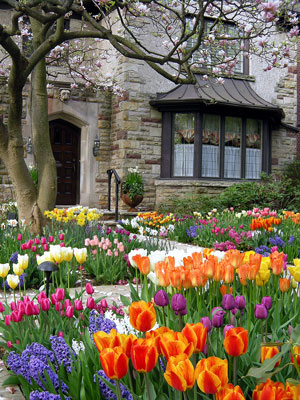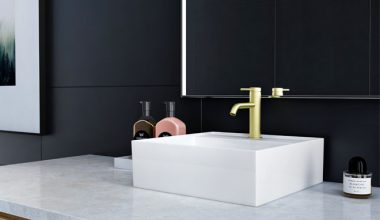
Story: Scott Brown, MAILDM MAIH
The thought process for the design of a front garden will often be different from that associated with a backyard. This is usually because there are basic differences in how we need our front and backyards to function.
Often, a front garden’s main function is to provide access to the home (and/or garage and/or front/side gate). This will affect what can be achieved in the front garden because elements such as a driveway and pedestrian access tend to take up considerable space — and they can impose physical limitations on the remaining area.
This is distinctly different from backyards, where access to the home, while still required, is not as likely to be the most significant consideration, nor have as great an impact on the rest of the space.
Another significant difference is that the relationship between the house and the front garden in terms of theme is very often more critical than for the backyard. Most often, the front garden is viewed from the street, providing a “snapshot” of the home and garden together. Commonly, the front garden is not a place where one will spend a great deal of time, so the visual relationship between house and garden is of considerable importance if a sense of place is to be achieved.
A period home is often a good example of the importance of relating the design of the front garden to the house. The front garden will best relate to the home if it features construction materials and plant species specific to the period of the home (that is, those popularly used during the original time period). Whether it be Victorian, Edwardian or even Arts & Crafts, the use of bluestone, tessellated tiles, old or handmade brick (especially arranged in a herringbone pattern), for example, can provide the link between house and garden.
This extends to the use of traditional plants such as roses, lavender and box hedges. Of course, it doesn’t mean the practical considerations are any less important as a front garden still needs to provide access to the house for vehicles and people.
The type of access required will be specific to the needs of the family. There might be a need for three cars to be parked side by side (which would mean a very wide driveway), for pram access (which might mean no steps or the construction of an alternative ramp) or for rubbish bins to be taken to the side gate (in which case you’d need a path rather than stepping stones).
A contemporary home will also require a sympathetic design approach for its front garden if a sense of place is to be achieved. The matching of style has to be deftly managed in conjunction with providing access to the home. Often, in modern house and landscape architecture, a minimalist approach is taken, whereby a smaller range of construction materials and plant varieties is used.
This theme has been extended in recent times to incorporate drought-tolerance and low-maintenance considerations. However, despite this style being quite different from that of the period house and garden, a pragmatic response to the access requirements is still required.
In addition to considerations of access and house style, there are other elements that may need to be incorporated in the design of a front garden if it has additional functions, such as providing privacy, or if structural work is needed to, say, retain a steep slope in the land.
For privacy, the selection and placement of a tree (or trees) or a hedge may be appropriate. However, as always, the solution must accommodate whatever access is required, and the plant selection and arrangement should relate to the style of the home.
Moreover, when planting trees or hedges for privacy, consideration should be given to the impact the trees or hedge will have on both the exterior and interior environments. If the house is south-facing, the use of a large tree or hedge planted in relative proximity to the home may impact on the amount of light received by any windows (and corresponding rooms).
Very often, the optimal solution for privacy is not the best option for light or access to the front door or windows of the house. In this case, a compromise solution is needed. A deciduous tree, which drops its leaves in winter and therefore lets light in, for example, represents one such compromise.
Alternatively, a front fence might be considered. This can potentially provide privacy and security without impacting on the amount of natural light that makes it way into the interior of the home. Access to the home can usually be preserved (as long as gates are positioned carefully) but some loss of the link between house and front garden is inevitable, especially if the fence is solid.
Fence style is yet another significant differentiation between designing front and backyards. In addition to considering the style and type of fence so it visually relates to the house and ensuring access to the house is not diminished, there are council regulations to be taken into account (especially if the fence is to be on the front boundary of the property).
Often there are height restrictions, dependent on construction materials and the degree of transparency. Similarly, building permits are commonly required, particularly for fences higher than 1200mm, or if they are of masonry (brick) construction. (This will vary from council to council, so always check before beginning any work.)
Finally, the letter box, house number and outdoor lighting warrant consideration. Access to the mailbox should be easy for both you and the postie to ensure you receive all your mail, while the more visible the house number, the easier it will be for visitors to locate your home.
When it comes to lighting, in front gardens there are several elements to consider. Practical lighting provides security and allows people to safely negotiate the pathways (and steps) to your door. This can be in the form of floodlighting and/or bollard path lighting that can be sensor-activated for convenience.
Mood or aesthetic lighting can enhance the overall look of the house and front garden. You might be surprised at how much the use of subtle accent lighting or feature lighting (uplighting a large tree, for example) will increase your enjoyment of your home.
About the author: Scott Brown is a Melbourne-based landscape designer and principal of Scott Brown Landscape Design.


